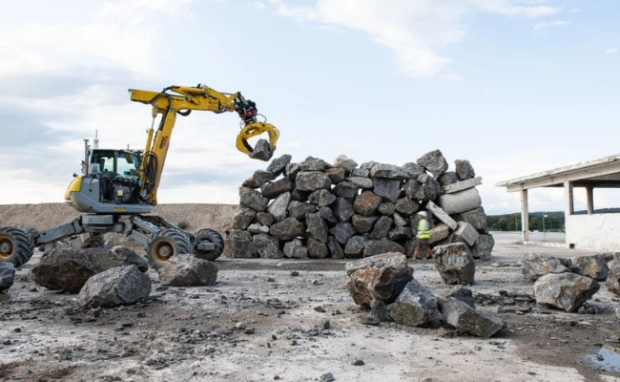Construction robot stacks walls by itself
Many imagine we will have construction robots that build homes without human intervention. However, you may have never imagined it would stack materials in an eco-friendly manner. Yet, a team of researchers recently created such a machine. Soon, they believe it could help solve the construction industry’s problems.
The world has been innovating on sustainable technologies and artificial intelligence, so why not merge them into one project? This construction robot lets robots build our environment-friendly future more efficiently than most humans. As a result, technology could lead us and our planet to a brighter tomorrow.
This article will discuss how the eco-friendly construction robot works. Then, I will cover some of similar innovations that provide a sneak peek into our robotic future.
How does the construction robot work?

A research team built an autonomous robot weighing 12 tons or 2,000 lbs that can construct stone walls from natural and recycled materials. They published their findings on the Science Robotics website, explaining how the machine works:
“Our system learns from real and simulated data to facilitate the online detection and segmentation of stone instances in spatial maps, enabling robotic grasping and textured 3D scanning of individual stones and rubble elements.”
“Given a limited inventory of these digitized stones, our geometric planning algorithm uses a combination of constrained registration and signed-distance-field classification to determine how these should be positioned toward the formation of stable and explicitly shaped structures.”
In other words, this bot uses advanced technologies to scan, sort, and stack concrete blocks and boulders in an efficient, eco-friendly way. Ryan Luke Johns and his team called their invention the hydraulic excavator for an autonomous purpose or HEAP.
They tested the construction robot at two sites, where it built a 32-foot-long freestanding wall and a 213-foot-long retaining wall using nearby rocks. Also, it creates 3D digital inventories of its materials so that it can reuse and recycle them for other projects.
You may also like: How Google Maps can help you be more eco-friendly
Interesting Engineering said these features enable the bot to build with local, low-energy, natural, and recycled materials. As a result, the industry can reduce its environmental impact and boost sustainability and efficiency.
“Beyond improvements to economic and production efficiency in building, robots also provide an opportunity to reduce the industry’s environmental footprint by enabling the direct use of local, low-energy, natural, and recycled materials as alternatives to concrete,” the researchers said.
They also said their machine can save up to 41% of carbon dioxide emissions compared to an ordinary reinforced concrete wall. However, they clarified that the robot is a proof-of-concept for the future of robotic construction.
What are the other recent robotics innovations?
It’s time for Atlas to pick up a new set of skills and get hands on. pic.twitter.com/osOWiiBlSh
— Boston Dynamics (@BostonDynamics) January 18, 2023
The US-based robotics firm Boston Dynamics demonstrated its construction robot in a video months ago. It featured the Atlas humanoid bot helping a human worker.
The worker asked Atlas to hand him his tool bag from an elevated scaffold. In response, it runs and leaps over several platforms toward the equipment container.
Eventually, it encountered a gap, so it crossed by putting a plank over it. Later, it reaches the tools, walks up the ascending wooden platforms, and crosses the makeshift bridge.
Afterward, it leaps over a higher wooden beam before throwing the tool bag to the worker’s platform. Atlas returns to the ground by pushing over a wooden box.
You may also like: NASA taps Austin firm to build Moon houses
Lastly, the robot jumps and flips onto the box. It pumps its left arm in celebration, to which the construction worker jokingly remarks, “Such a showoff.”
On the other side of the world, China announced it wants to mass-produce robots by 2025. President Xi Jinping said the country needs them to “promote industrial innovation with scientific and technological innovation, actively cultivate strategic emerging industries, such as new energy, new materials…”
“…advanced manufacturing and electronic information actively cultivate future industries, accelerate the formation of new productive forces, and enhance new momentum for development.”
Conclusion
A research team created a construction robot that can build structures by itself without human control. Also, it could choose eco-friendly materials to ensure sustainability.
However, Ryan Luke Johns and his team created it as a proof-of-concept. Consequently, we would need more research and development before they become mainstream equipment.
Learn more about the eco-friendly construction robot on its Science Robotics webpage. Also, check out more digital tips and trends at Inquirer Tech.